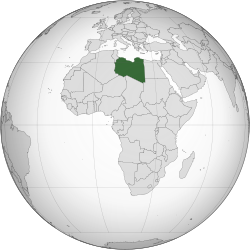Libya and nuclear technology
| Libya | |
|---|---|
| Nuclear program start date | 1969 |
| First nuclear weapon test | None |
| First fusion weapon test | None |
| Last nuclear test | None |
| Largest yield test | None |
| Total tests | None |
| Peak stockpile | None |
| Current stockpile | None; the program was dismantled in 2003. |
| Maximum missile range | 300 km (Scud-B) |
| NPT signatory | Yes |
Libya possesses chemical weapons and ballistic missiles and previously pursued nuclear weapons under the leadership of Muammar Gaddafi. On 19 December 2003, Gaddafi announced that Libya would voluntarily eliminate all materials, equipment and programs that could lead to internationally proscribed weapons, including weapons of mass destruction and long-range ballistic missiles. Libya signed the Nuclear Non-Proliferation Treaty (NPT) in 1968 and ratified it in 1975, and concluded a safeguards agreement with the International Atomic Energy Agency (IAEA) in 1980. The United States and the United Kingdom assisted Libya in removing equipment and material from its nuclear weapons program, with independent verification by the IAEA.
Libya acceded to the Chemical Weapons Convention effective 5 February 2004 and began destroying its chemical munitions later that year, but missed the deadlines for converting one chemical weapons production facility to peaceful use and for destroying its stockpile of mustard agent. In October 2014, Libya asked for foreign assistance to transport its 850 tonnes stockpile of precursor chemicals for making nerve gas out of Libya for destruction. In February 2015, Libyan military sources told media that unidentified armed men have captured large amounts of Libya’s chemical weapons, including mustard gas and sarin.
Before the rollback of its clandestine nuclear program in late 2003, Libya had a nuclear weapons program, allegedly to counter the covert Israeli nuclear program. In July 1968, Libya became signatory party of the Nuclear Non-Proliferation Treaty (NPT) under King Idris, ratifying the NPT treaty in 1975 under Colonel Muammar Gaddafi as well as concluding the IAEA safeguards agreement with the USSR in 1980. In 1981, the Soviet Union supplied a 10 MW research reactor at Tajura.
...
Wikipedia

